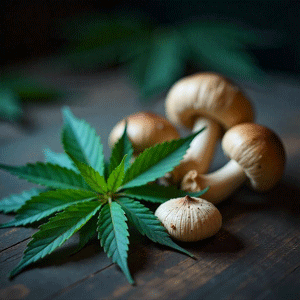Pain is personal, but so is healing. In a world flooded with pharmaceutical solutions, many people are rediscovering nature's pharmacy to manage pain without harsh side effects. This new wave of plant-based healing includes cannabinoids, terpenes, and an ancient but resurging ally: medicinal mushrooms.
In this blog, we will explore how these natural compounds work, how they support the body's healing systems, and why they are becoming go-to tools for people seeking safe, effective pain relief.
Cannabinoids: More Than Just CBD
Cannabinoids are the active compounds found in cannabis, with CBD (Cannabidiol) and THC (Tetrahydrocannabinol) being the most well-known.
These compounds interact with our endocannabinoid system (ECS), a regulatory network that maintains balance in pain perception, inflammation, mood, and immunity.
Research-Based Pain Benefits
- CBD has demonstrated strong anti-inflammatory and analgesic (pain-relieving) effects in both human and animal studies (Vučković et al., 2018).
- THC is particularly effective in treating neuropathic pain, often outperforming opioids in certain chronic conditions (NASEM, 2017).
Terpenes: Aroma With a Purpose
Terpenes are not just scent molecules; they are bioactive compounds that directly impact pain, inflammation, and mood by influencing receptors and neurotransmitters.
Top Terpenes for Pain Relief:
- Myrcene: Sedative and muscle relaxant; found in mango and thyme.
- Linalool: Calming and anti-anxiety; found in lavender.
- Beta-Caryophyllene (BCP): A dietary cannabinoid that binds to CB2 receptors, especially effective in managing chronic inflammation.
- Pinene: Anti-inflammatory and bronchodilator; found in pine and rosemary.
Each terpene works either alone or synergistically with cannabinoids in what's called the entourage effect, enhancing therapeutic benefits (Russo, 2011).
Medicinal Mushrooms: Ancient Wisdom Meets Modern Pain Relief
While cannabis and terpenes work through the ECS, medicinal mushrooms target different but complementary systems, primarily the immune and nervous systems. Many mushrooms contain beta-glucans, terpenoids, and antioxidants that help regulate inflammation, oxidative stress, and even nerve regeneration.
Top Medicinal Mushrooms for Pain:
Reishi (Ganoderma lucidum)
- Known as the "Mushroom of Immortality"
- Benefits: Anti-inflammatory, immune-modulating, and calming
- Use: Helpful for autoimmune pain, fibromyalgia, and tension-related aches
Lion's Mane (Hericium erinaceus)
- Supports nerve growth factor (NGF)
- Benefits: Neuroprotective, reduces neuropathic pain, enhances cognitive clarity
- Use: Ideal for nerve pain, brain fog, and stress-induced discomfort
Cordyceps (Cordyceps militaris)
- Natural energy booster and oxygen enhancer
- Benefits: Anti-fatigue, anti-inflammatory, and supports adrenal balance
- Use: Great for chronic fatigue-related pain and inflammatory joint conditions
Turkey Tail (Trametes versicolor)
- Rich in polysaccharopeptides
- Benefits: Modulates immune responses, reduces inflammation
- Use: Best for post-viral pain or immune-mediated chronic pain
Chaga (Inonotus obliquus)
- High in antioxidants like melanin and betulinic acid
- Benefits: Reduces oxidative stress and inflammation
- Use: Useful for arthritis, joint pain, and oxidative damage
The Power of Synergy: Combining Cannabinoids, Terpenes and Mushrooms
Here is where things get exciting: these three groups, cannabinoids, terpenes, and medicinal mushrooms, don't just work well on their own. They complement each other beautifully.

CBD + Lion's Mane:
May support nerve repair and reduce neuroinflammation
THC + Reishi:
Calms both pain and anxiety, great for tension-related pain
Beta-Caryophyllene + Cordyceps:
Immune balance with anti-inflammatory support
Myrcene + Chaga:
Potent antioxidant duo for arthritis or ageing-related pain
Many holistic formulations and wellness brands are now combining these ingredients in tinctures, capsules, teas, and topicals to create well-rounded, plant-powered pain management solutions.
How to Use These Compounds Safely
- Start Low, Go Slow: Whether trying CBD or reishi, begin with small doses.
- Look for Full-Spectrum or Whole-Food Products: These preserve synergistic compounds.
- Check for 3rd-Party Testing: Especially important for mushrooms and cannabis products.
- Talk to Your Healthcare Provider: Especially if you are taking medications or have underlying conditions.
Conclusion
Our final thought is that your body knows best. Pain is not just a symptom; it is a signal. And nature has given us an array of allies that not only quiet that signal but help us heal at the source. Whether you are navigating chronic pain, recovering from injury, or just seeking a gentler alternative to over-the-counter drugs, the natural trio of cannabinoids, terpenes, and medicinal mushrooms offers a grounded, effective, and empowering approach.
References:
- Vučković, S. et al. (2018). Cannabinoids and pain: New insights for old molecules. PMC
- Gertsch, J. et al. (2008). Beta-caryophyllene is a dietary cannabinoid. PubMed
- Russo, E. (2011). Taming THC: Potential cannabis synergy and phytocannabinoid-terpenoid entourage effects. PMC
- Friedman, M. (2016). Chemistry, nutrition, and health-promoting properties of Hericium erinaceus (Lion's Mane) mushroom. Pubmed
- Wasser, S.P. (2014). Medicinal mushroom science: Current perspectives, advances, evidences, and challenges. PubMed
Disclaimer: This blog supports responsible cannabis use. The information contained in this article is for educational and informational purposes only and is not intended as health or medical advice. Always consult a physician or other qualified health provider regarding any questions you may have about a medical condition or health objectives.
Natural Pain Relief